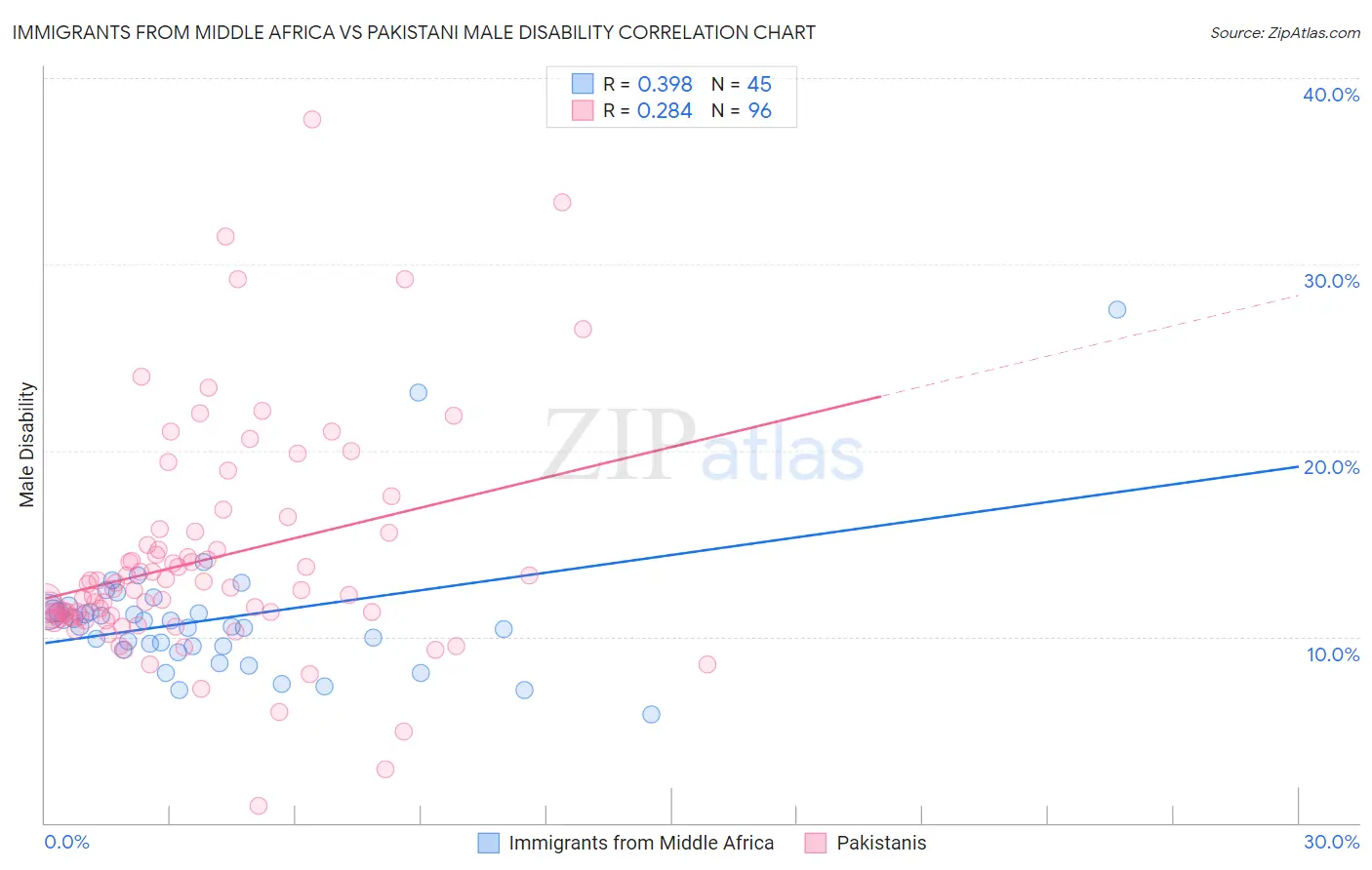Immigrants from Middle Africa vs Pakistani Male Disability
COMPARE
Immigrants from Middle Africa
Pakistani
Male Disability
Male Disability Comparison
Immigrants from Middle Africa
Pakistanis
11.1%
MALE DISABILITY
70.9/ 100
METRIC RATING
155th/ 347
METRIC RANK
11.3%
MALE DISABILITY
30.3/ 100
METRIC RATING
185th/ 347
METRIC RANK
Immigrants from Middle Africa vs Pakistani Male Disability Correlation Chart
The statistical analysis conducted on geographies consisting of 202,727,084 people shows a mild positive correlation between the proportion of Immigrants from Middle Africa and percentage of males with a disability in the United States with a correlation coefficient (R) of 0.398 and weighted average of 11.1%. Similarly, the statistical analysis conducted on geographies consisting of 335,283,610 people shows a weak positive correlation between the proportion of Pakistanis and percentage of males with a disability in the United States with a correlation coefficient (R) of 0.284 and weighted average of 11.3%, a difference of 2.4%.

Male Disability Correlation Summary
| Measurement | Immigrants from Middle Africa | Pakistani |
| Minimum | 5.8% | 0.92% |
| Maximum | 27.6% | 37.8% |
| Range | 21.8% | 36.8% |
| Mean | 11.0% | 14.1% |
| Median | 10.5% | 12.5% |
| Interquartile 25% (IQ1) | 9.4% | 11.0% |
| Interquartile 75% (IQ3) | 11.3% | 15.2% |
| Interquartile Range (IQR) | 1.9% | 4.2% |
| Standard Deviation (Sample) | 3.6% | 6.1% |
| Standard Deviation (Population) | 3.6% | 6.0% |
Similar Demographics by Male Disability
Demographics Similar to Immigrants from Middle Africa by Male Disability
In terms of male disability, the demographic groups most similar to Immigrants from Middle Africa are Russian (11.1%, a difference of 0.070%), Immigrants from Western Africa (11.1%, a difference of 0.11%), Immigrants from Moldova (11.1%, a difference of 0.14%), Immigrants from Northern Europe (11.1%, a difference of 0.16%), and Latvian (11.1%, a difference of 0.18%).
| Demographics | Rating | Rank | Male Disability |
| Sudanese | 77.1 /100 | #148 | Good 11.0% |
| Immigrants | Denmark | 76.4 /100 | #149 | Good 11.0% |
| Immigrants | Guatemala | 75.1 /100 | #150 | Good 11.0% |
| Cubans | 74.9 /100 | #151 | Good 11.0% |
| Immigrants | Albania | 74.4 /100 | #152 | Good 11.0% |
| Immigrants | Northern Europe | 73.2 /100 | #153 | Good 11.1% |
| Immigrants | Moldova | 72.8 /100 | #154 | Good 11.1% |
| Immigrants | Middle Africa | 70.9 /100 | #155 | Good 11.1% |
| Russians | 69.8 /100 | #156 | Good 11.1% |
| Immigrants | Western Africa | 69.2 /100 | #157 | Good 11.1% |
| Latvians | 68.1 /100 | #158 | Good 11.1% |
| Guatemalans | 67.2 /100 | #159 | Good 11.1% |
| Albanians | 66.5 /100 | #160 | Good 11.1% |
| Immigrants | West Indies | 65.7 /100 | #161 | Good 11.1% |
| Immigrants | Haiti | 65.3 /100 | #162 | Good 11.1% |
Demographics Similar to Pakistanis by Male Disability
In terms of male disability, the demographic groups most similar to Pakistanis are Iraqi (11.3%, a difference of 0.010%), Immigrants from Central America (11.3%, a difference of 0.16%), Immigrants from Zaire (11.4%, a difference of 0.18%), Immigrants from Austria (11.4%, a difference of 0.20%), and Immigrants from Belize (11.3%, a difference of 0.21%).
| Demographics | Rating | Rank | Male Disability |
| Australians | 42.2 /100 | #178 | Average 11.3% |
| Immigrants | Caribbean | 41.4 /100 | #179 | Average 11.3% |
| Hondurans | 41.1 /100 | #180 | Average 11.3% |
| Immigrants | Senegal | 34.4 /100 | #181 | Fair 11.3% |
| Immigrants | Belize | 33.7 /100 | #182 | Fair 11.3% |
| Immigrants | Central America | 32.9 /100 | #183 | Fair 11.3% |
| Iraqis | 30.5 /100 | #184 | Fair 11.3% |
| Pakistanis | 30.3 /100 | #185 | Fair 11.3% |
| Immigrants | Zaire | 27.6 /100 | #186 | Fair 11.4% |
| Immigrants | Austria | 27.3 /100 | #187 | Fair 11.4% |
| Estonians | 26.8 /100 | #188 | Fair 11.4% |
| Immigrants | Netherlands | 25.9 /100 | #189 | Fair 11.4% |
| Immigrants | Bosnia and Herzegovina | 25.4 /100 | #190 | Fair 11.4% |
| Senegalese | 23.2 /100 | #191 | Fair 11.4% |
| Assyrians/Chaldeans/Syriacs | 23.2 /100 | #192 | Fair 11.4% |